The Wadi that Wouldn’t End
PeriBlog XV: Wadi Al-Qelt
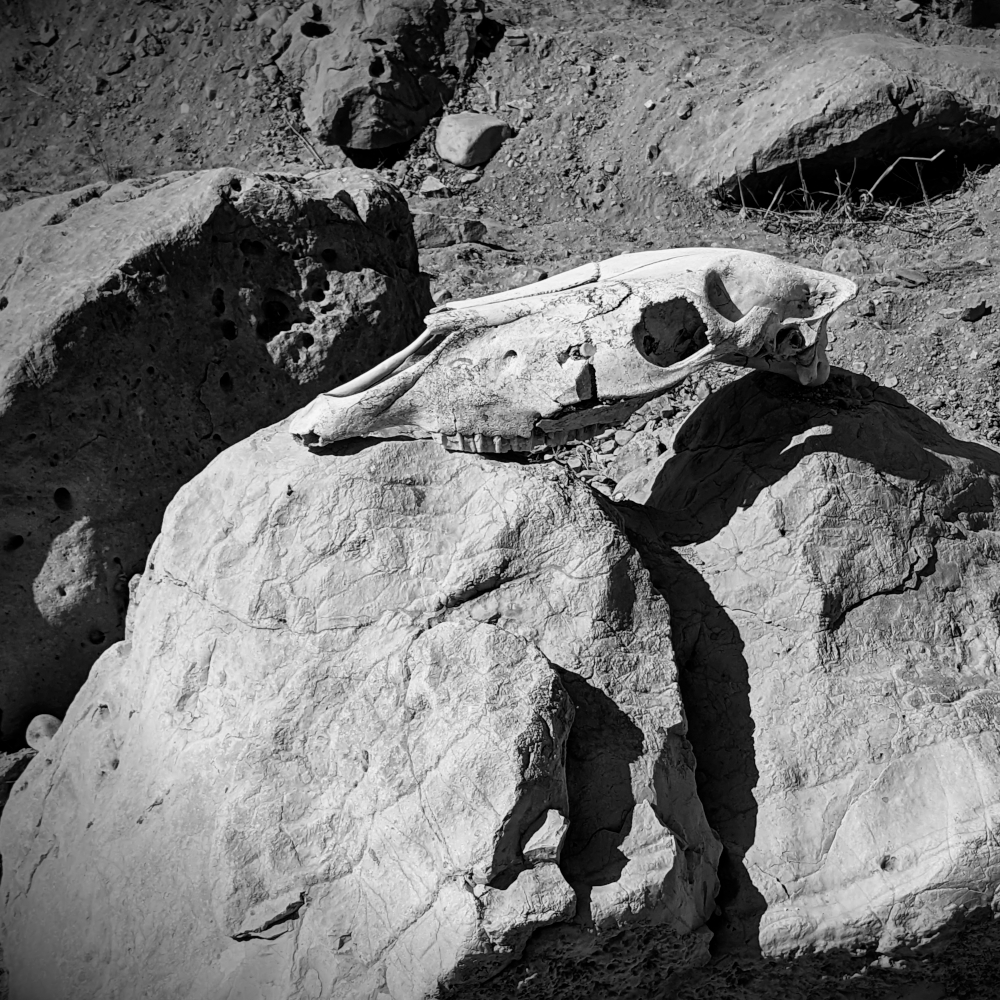
Not everyone makes it out of the Wadi alive
“So how about a lovely hike?” asked my sweet wife. “We could use a break. Get outdoors and see some of the countryside.”
“Yes, yes,” I murmured in a distracted rather than a heartfelt manner.
Be careful with inattentive assent. You just never know when detachment will bite you in the gluteus maximus. That’s what I thought as I clambered aboard a long, white tour bus parked on a Friday morning Ramallah street. The interior of the bus was ablaze with red strip lighting. Yellow smiley faces hung from the ceiling vents. Sitar rock flayed an overly-caffeinated stereo speaker.
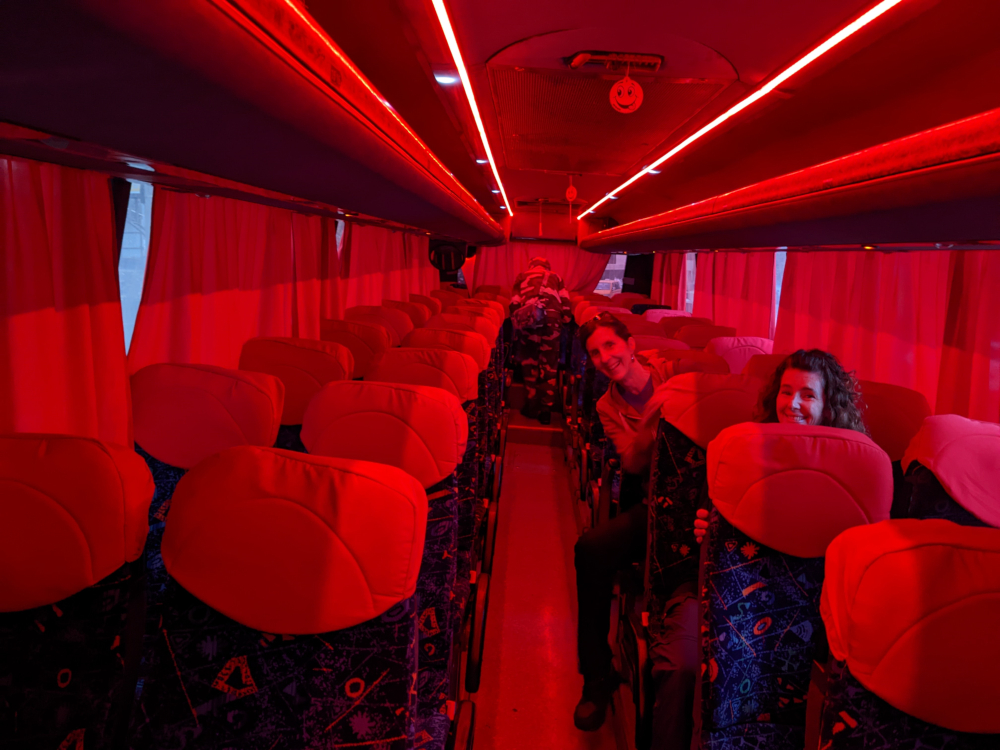
Surely this is the wrong bus
Where were we going? I wasn’t completely sure. A hike, about twelve kilometers. There was supposed to be a monastery and possibly other ruins. It was going to take all day—budget ten hours, we were told.
Ten hours to hike 12 kilometers? Were we going to crawl the entire way?
The Big Hike
Friday mornings are quiet in Ramallah. The equivalent of Christian Sunday or Jewish Saturday, the day is reserved for prayer in Islam. The city’s normal work morning rush is absent; you can stroll across the street without the danger of being struck by a fast-moving taxi. Nevertheless, some folks were moving. Many of them seemed quite young, and they headed for the bus.
As they clambered aboard, the average age of our group declined precipitously. Gen-Z filled the seats, crowding the Baby boomers.
Finally the bus fired up, the driver cranked up the stereo system to drown the nasty engine noise, and we were off. Palestinian rap supplanted the Bollywood music. Young girls in the seats ahead of me began swaying like cobras.
Memo to self: bring ear plugs on future expeditions.
We rolled through Ramallah and out into the open countryside. The bus turned east and entered a barren chalky landscape. Small herds of goats scrabbled for sustenance among the bare rocks littering the landscape. It was a great place to test lunar landers. Only the occasional Bedouin camp, lashed together from scavenged sheet metal and broken boards, disrupted the emptiness.
Our bus ground to a halt at an overlook perched on the rim of a steep-walled canyon. This, I later learned, was the Wadi Al-Qelt, a deep fissure in the earth carved by the Ein Prat—a small, seasonal river. It was also, explained a nearby sign, the home of St George’s Monastery, one of the few Christian abbeys still active in this land.
Two other tour buses beat us to the parking lot. Clumps of tourists were already marching down into the canyon to visit the monastery. Bedouins did a brisk business in the parking lot: hand-crafted jewelry, cold drinks and food, and donkeys stood ready for the arriving crowds.
Donkeys?
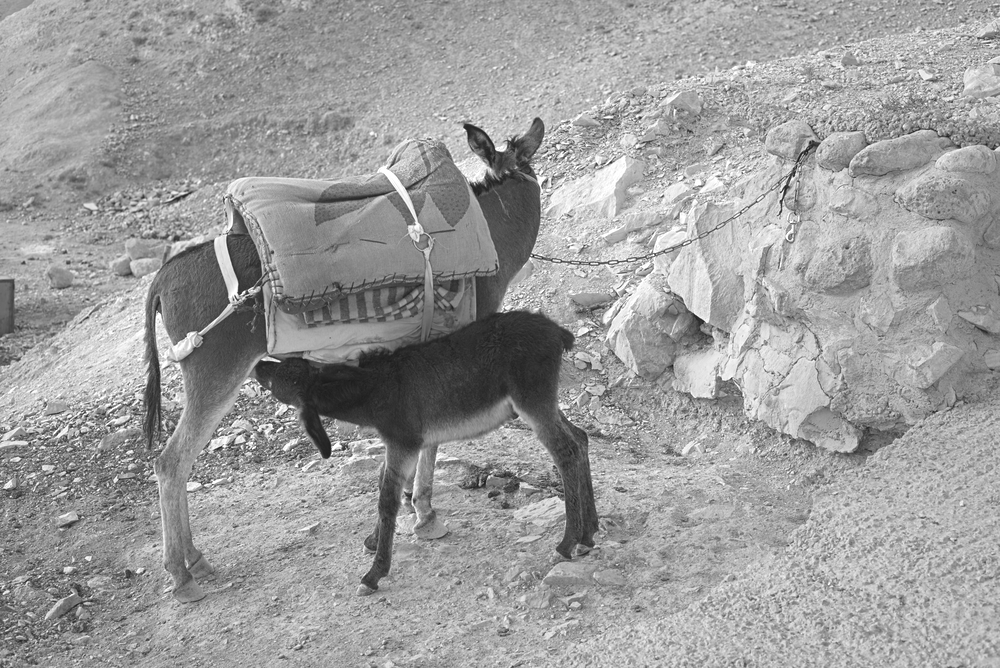
A mother donkey and her foal
The drivers offer rides down the steep trail to the monastery. They also offer rides—probably at a premium—back up the hill to the parking lot. Business was slow in the cool of this morning, but I imagined there would be many riders later in the day.
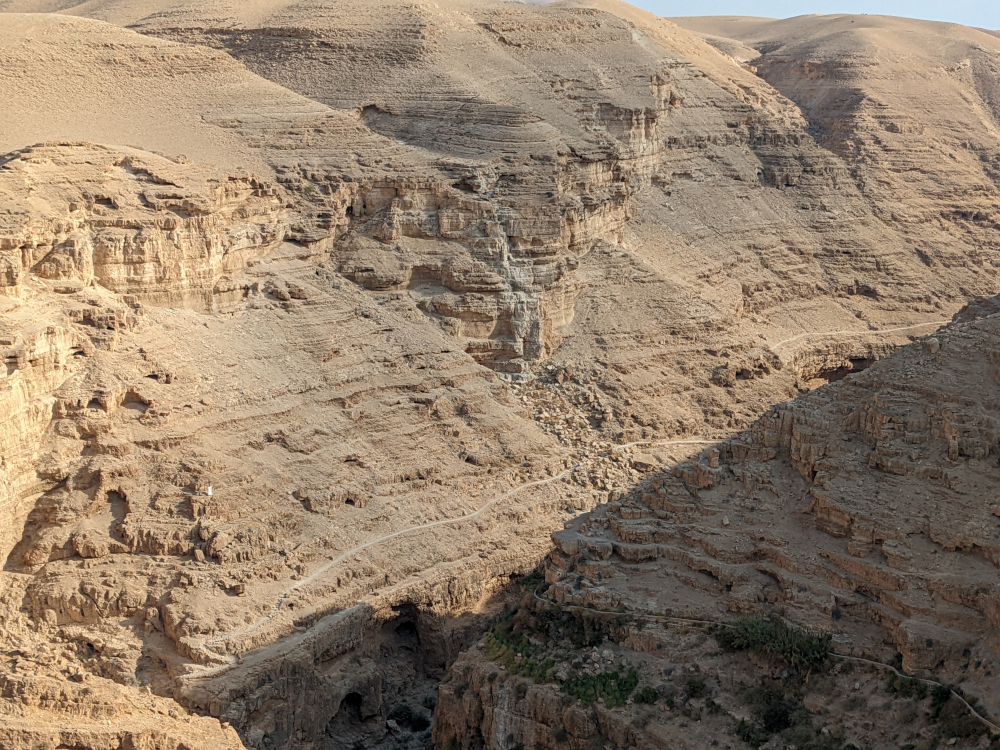
The view from the top: Wadi Al-Qelt
Our group wouldn’t be returning. The day’s hike followed the line of the canyon, heading west for Jerusalem. The bus would collect us at the end of the day at some undisclosed location.
We plunged down into the canyon. Soon St George’s monastery, clinging like a giant swallow’s nest to the face of the northern cliff, appeared below our feet.
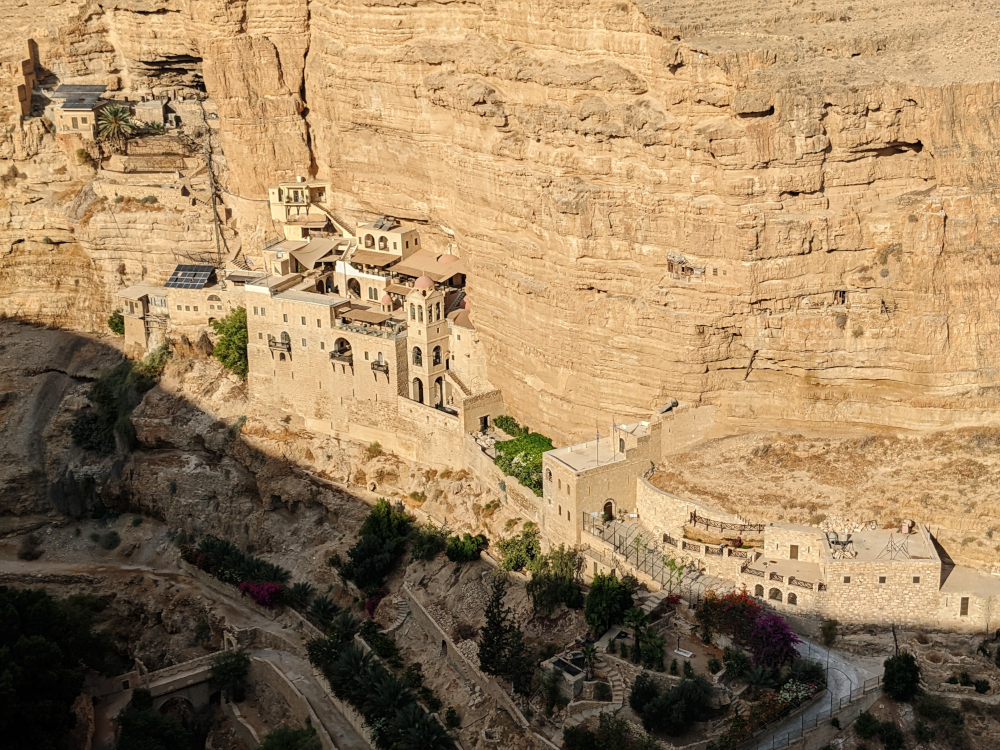
St George’s Monastery
The monastery, asserts tradition, is built around the cave where the prophet Elijah took refuge when Ahab, the seventh king of Israel, tried to kill him. According to I Kings 17:1-6, Elijah fled into the desert and lived in a cave. Ravens brought him bread and he drank from a nearby stream.
I am skeptical that the Wadi Al-Qelt contains Elijah’s cave. Crows haunt the canyon—they swooped across the open sky all morning—but the Bible does assert (1 Kgs 17:3) that the cave was in the Kerith Ravine, “east of the Jordan.”
We are most assuredly west of the Jordan, so I am a little puzzled why anyone would claim that this was Elijah’s famous retreat.
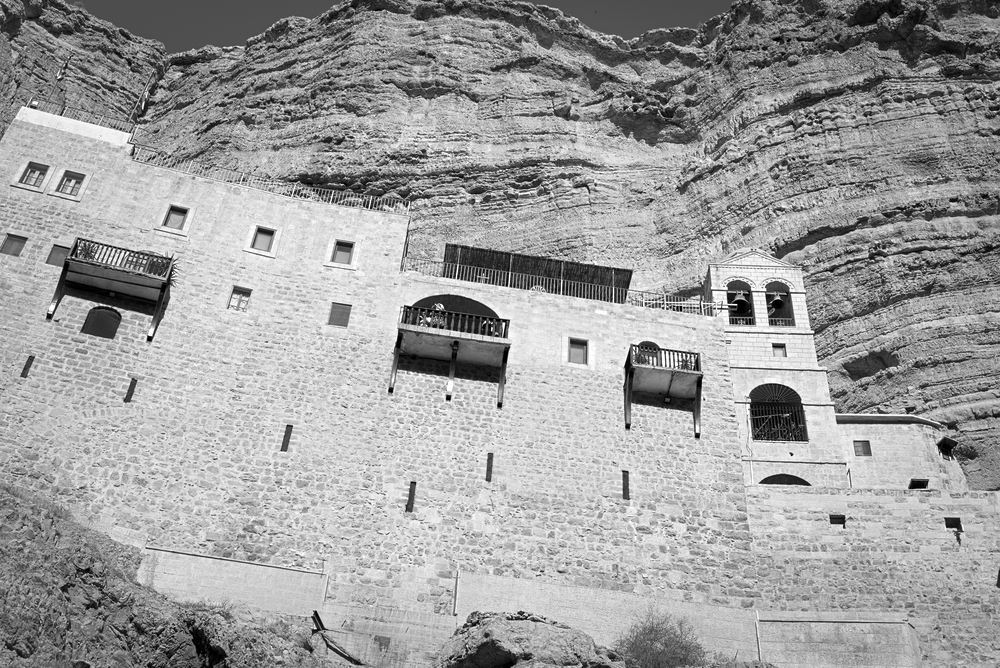
St George’s Monastery
Unfortunately, we were a hiking party rather than a group of ecclesiastical myth-busters. After reaching the bottom of the canyon we admired the monastery for a few minutes, and then turned our faces west. I didn’t have a chance to enter the cloister—a pleasure that I shall have to defer for a later date.
Vegetation—palm trees, reeds, and a spiky plant that some of our colleagues claimed was poison ivy(?)—crowded the watercourse at the bottom of the canyon. The river was mostly dry at the end of the hot season, but the eroded limestone testified to its rainy season power.
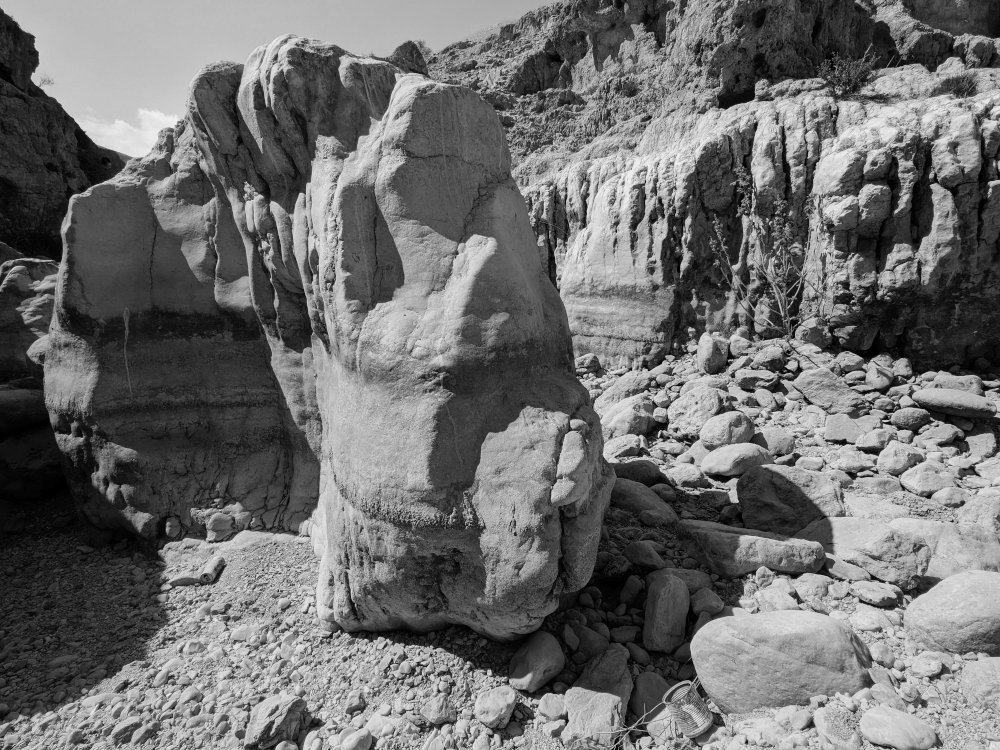
River-carved limestone
Upstream from the monastery we passed beneath the ruins of a Roman aqueduct. 2,000 years ago this Roman masterpiece carried fresh water to Jericho. A portion of the ancient structure had collapsed, but it was still possible to appreciate the genius of Roman engineering.
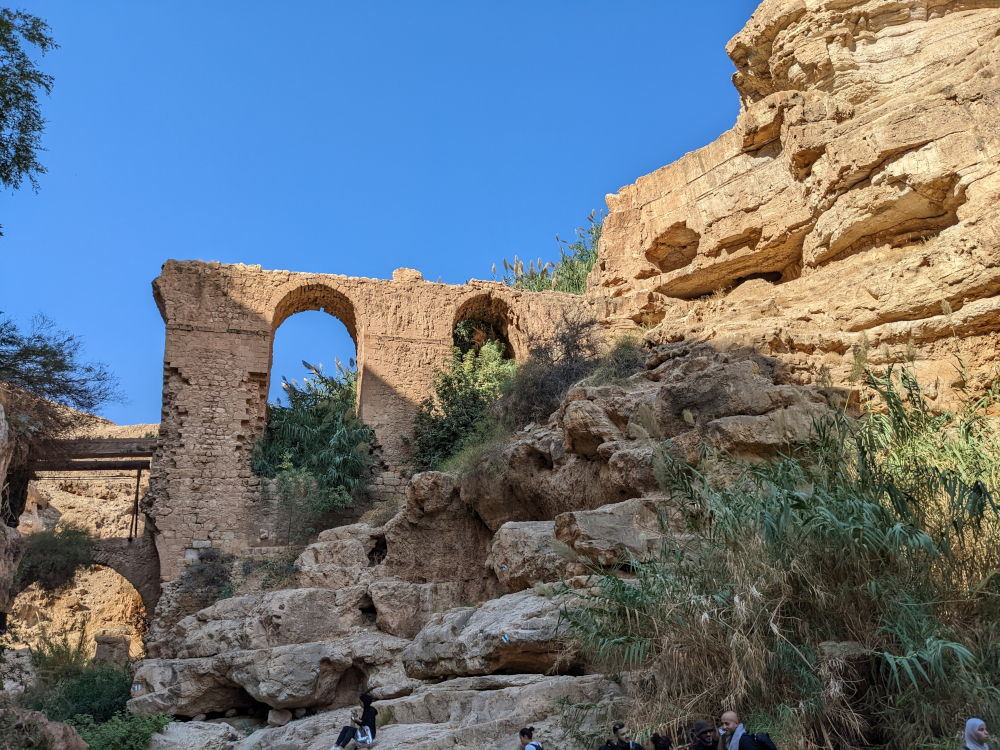
Ruins of an ancient aqueduct
We followed the streambed west, stumbling over river-rolled rocks. Our party moved slower than I liked, and as the group tired, rest breaks arrived at shorter intervals. Walk fifteen minutes, rest ten. Walk fifteen, rest ten. I found the pace a bit maddening, but the frequent stops offered many chances to take photographs.
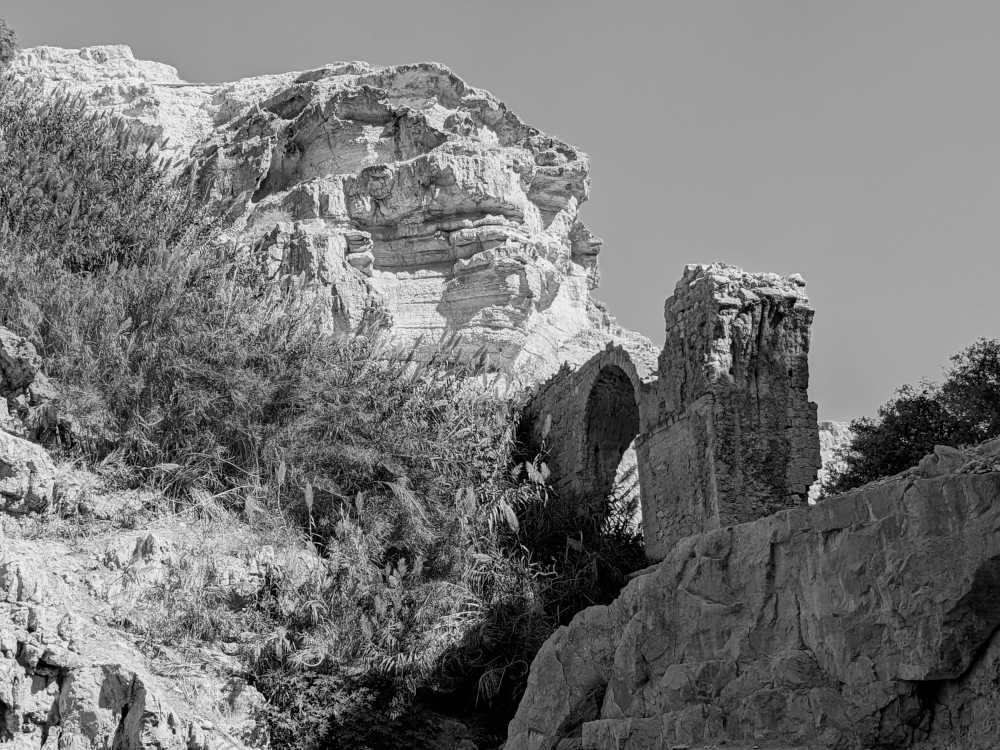
Aqueduct, Wadi Al-Qelt
Even with numerous rest stops, the group pace slowed. The autumn sun intensified, pushing the temperature toward the 90 degree mark. I sipped my water judiciously, conserving it for the path ahead.
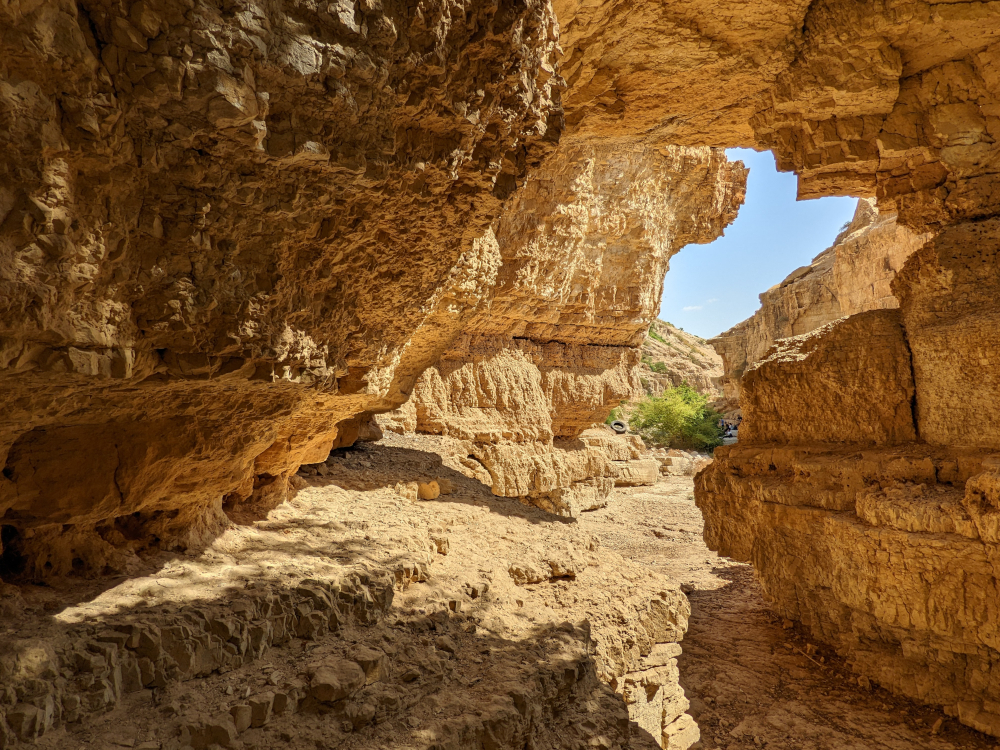
Cave of light, Wadi Al Kelt
Some biblical scholars have identified this canyon with Psalm 23.4: “Yea, though I walk through the valley of the shadow of death, I will fear no evil: for thou art with me; thy rod and thy staff they comfort me.” Our party hadn’t reached a terminal point yet, but some of the hikers were growing weary and most lacked the comfort of a staff.
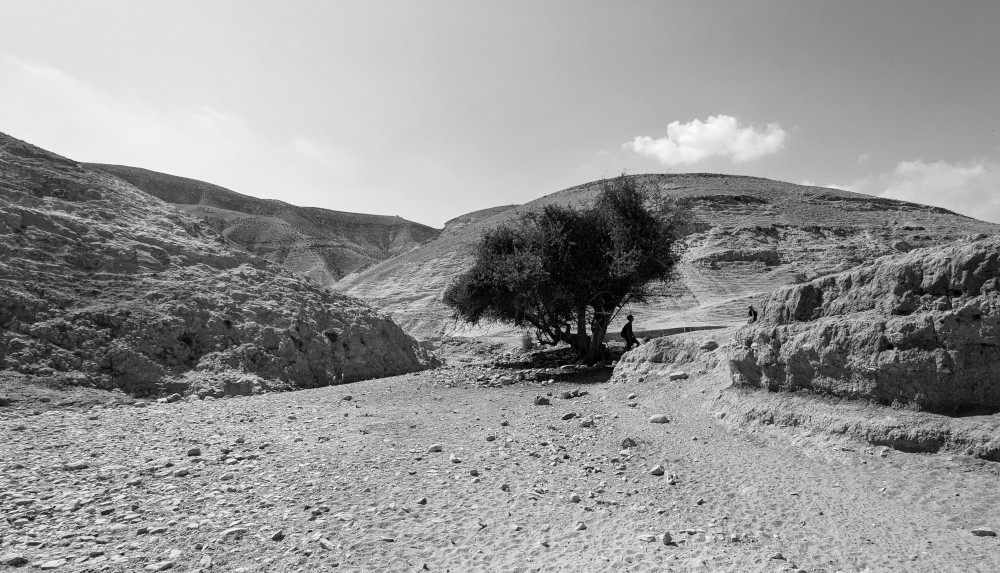
Through the shadow of the Valley of Death
As we continued west, the hills surrounding the wadi grew rounder and shorter. Finally, we walked into an open space that offered a spectacular view of the surrounding landscape.
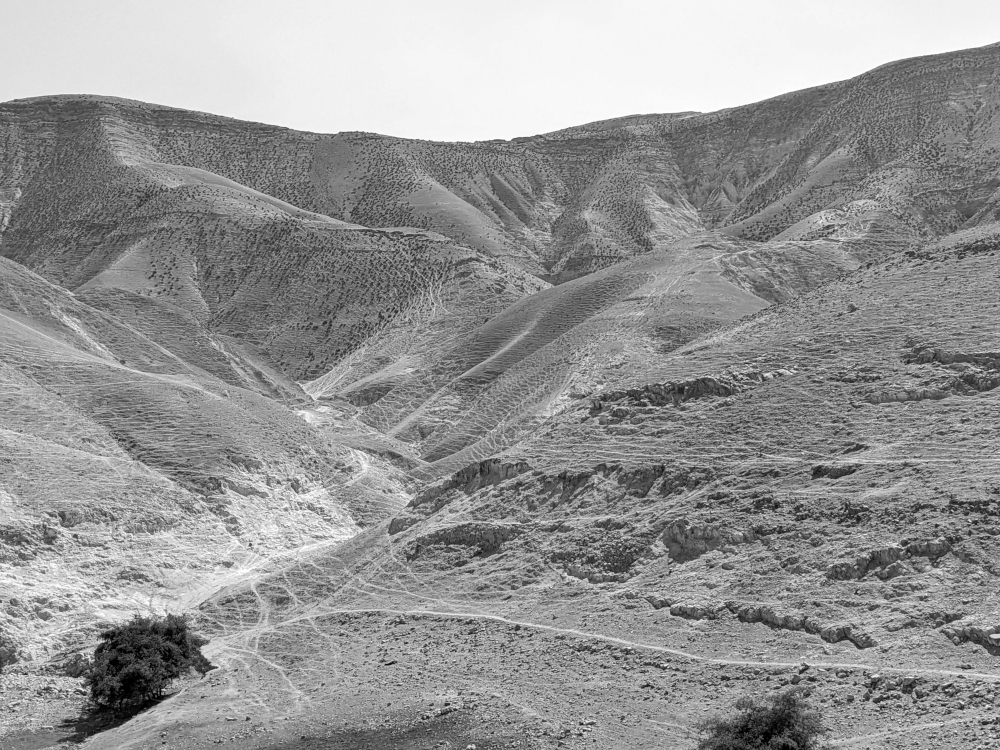
The canyon walls fall away, unveiling a marvelous view
Goat trails scarred the mountains, a fine skein that overlaid the slopes. The herds scour the mountains for small tufts of dried grass. A goat’s life isn’t easy.
A large pool of water, feeding an irrigation trough, stood at the western end of our hike. Time for another rest break.
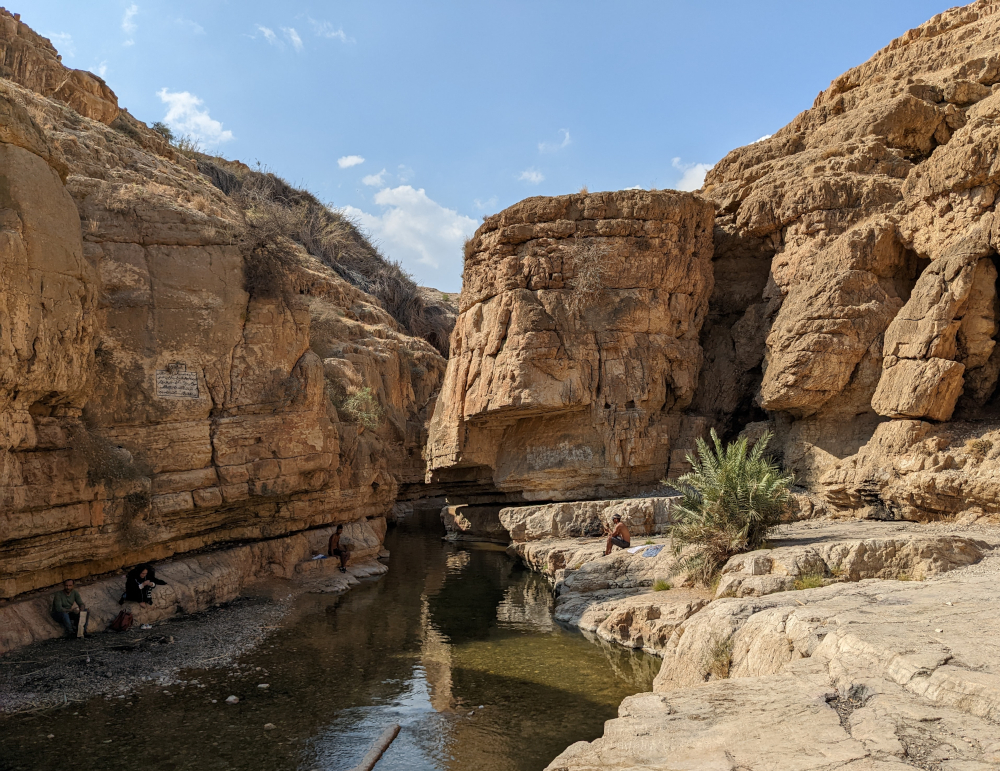
A refreshing desert oasis
While the kids waded and splashed water, I found a quiet spot on a nearby hillside, sitting in front of a nice cave. I can imagine a desert father wanting to set up shop here. A path leads down to the water. You could carry buckets of water up the hill to irrigate a kitchen garden.
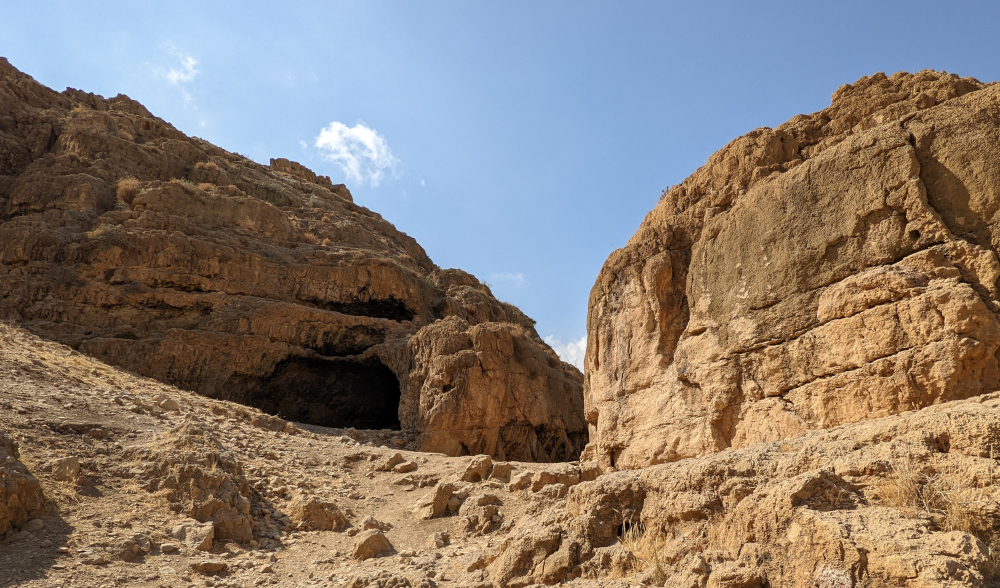
A fine cave with an upper room.
Judaism, Christianity, and Islam are all desert religions, born in the deep silence of the arid emptiness. Here, in this desolate landscape, the patriarchs and prophets heard the voice of God. I was denied that great mystical experience. As I crouched in front of my cave, I only heard the voice of a stereo, blasting the annoying music that accompanied my group’s impromptu pool party.
The last stage of the hike was brutal. We paper-clipped around the oasis, and then headed east, along the southern side of the stream. The trail broke out of the canyon, revealing a steep hillside with white stone steps laddering the slope. Several cars were parked at the top of the stairs. My heart sung. Climb the hill and the hike would be finished.
I started up. To the south, another piece of the old Roman aqueduct spanned a valley. I stopped to snap photos whenever I needed to catch my breath.
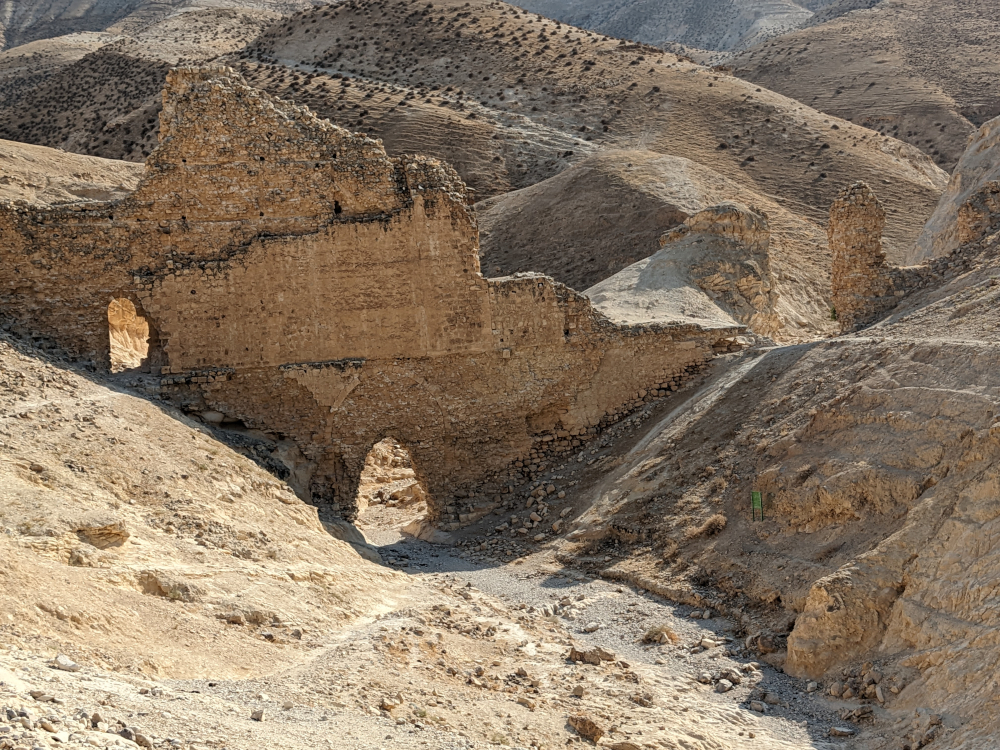
A Roman aqueduct graces the valley
Had we begun our hike here, I would have wanted to climb down the valley and take closeups of the amazing structure. Wearing my fatigue like a fur coat, I was content just to make pictures from a distance.
A last spurt of energy, a quick scramble to the top, and I entered the parking lot, ready to collapse.
Something was missing. No bus.
“First stage done,” said our guide. He pointed at the gravel road that continued east, spiraling up even higher hills.
Words failed me.
There is a particularly acute pain that accompanies the disappointment of a false summit. The temperature was well north of ninety degrees. We had been sweltering in the sun for hours. I was nearly out of water. My energy gauge had dropped to the “running on fumes” mark. Why can’t they just drive the bus down and pick us up, I thought.
But they didn’t. With tears in my eyes, I hitched up my backpack and began the long trek higher.
Minutes turned into painful hours. As the sun baked me into a potato crisp, I reflected on the fact that I am sixty.
I’m getting too old for this stuff.
Finally, I reached the top. I’ve never been happier to see a big white bus, our ride home. Fire up the Palestinian rap music! Just let me sit down.
A Bedouin camel stood near a couple of small booths. One man was crushing pomegranates to make a pink sparkling drink. The camel driver ignored us, convinced that hard core hikers wouldn’t be eager to mount his surly beast. He was wrong—if he had met me at the bottom of the hill, I would have been happy to make a generous contribution to the local camel industry.
Location is everything.
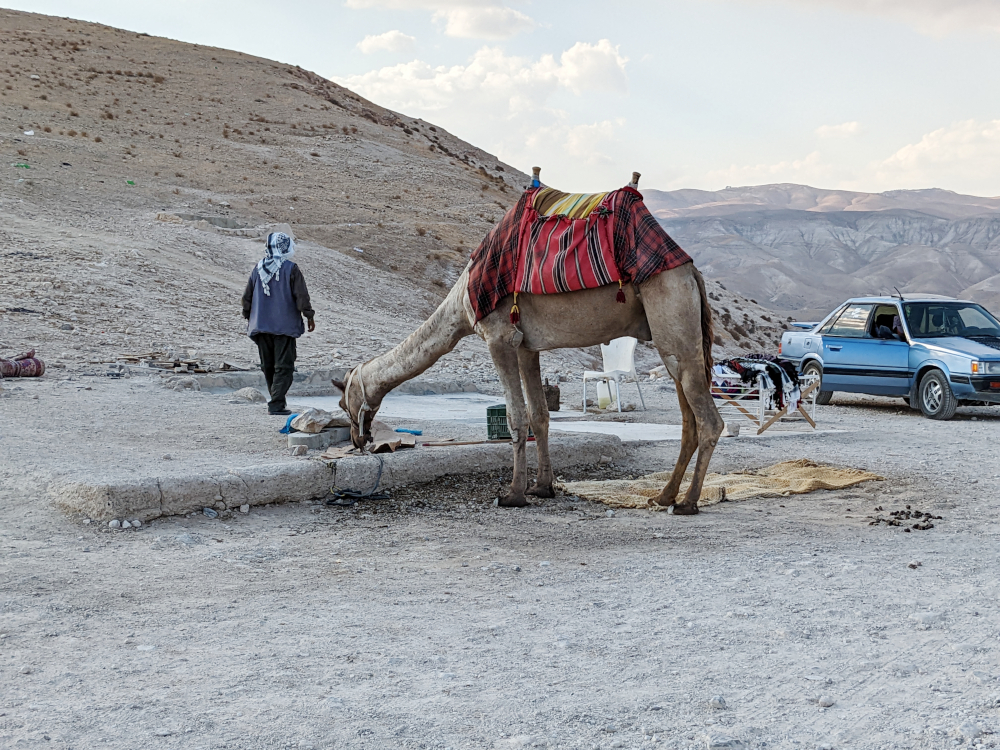
Where was this guy when I needed him?
We sat in our bus, waiting for our group’s stragglers to finish the climb. A tour bus rolled into the parking lot and disgorged a crowd of Holy Land tourists. The camel guy came to life, parading his steed in front of the newcomers.
With a roar of diesel exhaust, our bus came alive and we pulled out of the parking lot. It was an arduous day, but it was worth it. I may be sixty, but I am not ready to surrender to tour group travel. They may be slow and have inexecrable taste in music, but I will stick with my Palestinian hiking club.
If you are enjoying this series, why not subscribe to Richard's monthly newsletter, What's New in Old News? The Peripatetic Historian is on the road, roaming the world and compiling fresh adventures. Don't miss out. Click here to join the legions of above-average readers who have already subscribed.